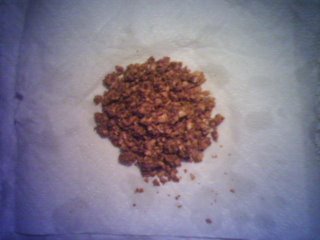
While fishing and gardening has provided a large amount of consumables, I decided to give the arts of gathering and herblore a try. Seeing that I have the day off from work, the normal "munday" tasks have been replaced by activities that induces some small degree of sanity. I went into the woods to gather some acorns and mushrooms. Unfortunately there hasn't been rain in almost two weeks here in the northeast and thus no edible fungus was to be found. On the flip side, I did manage to collect some 25 lbs of ripe acorns. Acorns, the seeds of oak trees, are rich in carbohydrates. However, the catch is two fold:
1. You would have to compete with squirrils and other wily rodents to get your share of the crop. To my chagrin, this turned out to be no easy task. 2 out of 3 acorns that I found have been thoroughly gnawed by these frisky devils.
2. Each acorn contain trace amounts of tannin which is extremely bitter and has to be leached out of the meat of the acorn.
The native american tribes of the North East used to consume large amounts of acorn meal. They would first remove the acorn shells and collect the meat. The meat would then be pounded into meal. The meal is wrapped tightly into a semi-porous sack and left for a day under a cold flowing stream. The stream water carries away the tannin and leaves the acorn meal ready for human consumption. I'm going to try a much faster approach. A few pounds of the collected acorn will be shelled and mashed. This mash will be boiled in water until the water turns yellow, then the water is drained and fresh water poured in for more boiling. This boiling will quickly leach out the tannin.
So I took 3 lbs of acorns and shelled them with a nut cracker. About 10% of them were rotten/discoloured/worm-infested. The acorn meat was then pounded in a metal bowl until it turned into a fine pasty meal. This paste was then boiled repeatedly with tap water.
 After each boiling the water was drained off and the acorn meal quenched with clean water. The run-off water was of this cloudy yellow-orange colour. After the second boiling I tasted a morsel of the acorn meal, it had a very bitter after-taste. So I boiled it some more. After the 4th boiling, the water became somewhat less yellowish and more clear. After the fifth boiling the water was entirely clear. I then drained all the water and pressed the excess water from the meal. The processed acorn meal was left to dry overnight on some paper towels. When considering the potential of acorn meal as a food source, I do not have the greatest of confidence. 3lbs of acorns and 2 hours of work produced less than 1/3 of a pound of acorn meal. And I know the caloric value of this meal couldn't possibly be greater than 1/3 pound of flour or even millet. Moreover, the taste of this acorn meal is bland and very coarse, kind of like flat, unflavored, canary seed.
After each boiling the water was drained off and the acorn meal quenched with clean water. The run-off water was of this cloudy yellow-orange colour. After the second boiling I tasted a morsel of the acorn meal, it had a very bitter after-taste. So I boiled it some more. After the 4th boiling, the water became somewhat less yellowish and more clear. After the fifth boiling the water was entirely clear. I then drained all the water and pressed the excess water from the meal. The processed acorn meal was left to dry overnight on some paper towels. When considering the potential of acorn meal as a food source, I do not have the greatest of confidence. 3lbs of acorns and 2 hours of work produced less than 1/3 of a pound of acorn meal. And I know the caloric value of this meal couldn't possibly be greater than 1/3 pound of flour or even millet. Moreover, the taste of this acorn meal is bland and very coarse, kind of like flat, unflavored, canary seed.
No comments:
Post a Comment